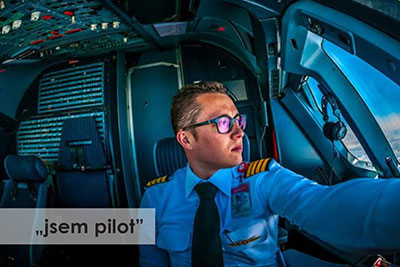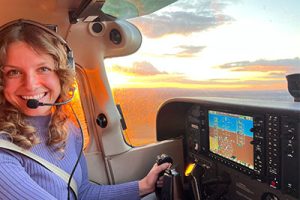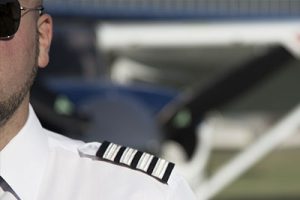How to Become a Commercial Airline Pilot
Many people ask us about the steps to become a commercial airplane pilot. They want to know what’s involved, the requirements, the duration of training, and how long it takes before they can fly a commercial plane. Cost is also a big concern. If you’re aspiring to be a commercial pilot, now is a great time as the demand is increasing. After training, you’ll have job opportunities with Czech and other international airlines. In this article, we’ll simplify the process of becoming a commercial airplane pilot and guide you through the adventure.
First Officer position in Commercial Airline
When you start your career as a pilot for a commercial airline, your initial position is the First Officer (FO). You’ll be seated in the right cockpit seat, working alongside the commanding captain who occupies the left seat. With the accumulation of sufficient experience, i.e. reaching 1500 hours as a pilot, including at least 500 hours in a multi-pilot environment, you become eligible for the Airline Transport Pilot License (ATPL). After gaining additional experience over a few more years, you can progress to the captain position, shifting to the left seat in the cockpit and enjoying an increase in your salary.
From Zero to Airline Transport Pilot
Training Period
Before you take your seat as a First Officer in the right seat of the cockpit of a commercial airplane, you will undergo training that realistically takes about 2 years. The duration is highly individual and influenced by many factors, but two factors play a primary role:
- Your time commitment to training.
- Sufficient financial resources.
Another significant factor is your diligence and determination to learn and persevere. However, that is a matter for each individual, and it can be discussed in a separate article. In summary, the entire training process from zero to becoming an airline transport pilot takes approximately 2 years, assuming you are not engaged in other activities. But you can be confident it’s a worthwhile investment!
Required Licenses and Their Acquisition
To be considered for the First Officer (FO) position with any airline, you must hold specific licenses and undergo essential training. These include:
- Commercial Pilot License with an Instrument Rating (CPL, IR)
- Multi-Engine Piston Rating with an Instrument Rating (MEP, MEP IR)
- Multi-Crew Cooperation Training (MCC)
- Advanced Upset Prevention and Recovery Training (Advance UPRT)
We will further elaborate on the requirements and provide guidance on how to obtain each of these licenses.
Training Format
There are various ways to obtain licenses and certifications, but fundamentally, there are two approaches:
A) Modular Course:
- The modular training system for commercial airplane pilot training involves training in separate, sequentially connected modules, or stages of training, concluding with the acquisition of a pilot’s license or qualification. This approach allows for flexibility as you can complete each module at your own pace. During the training, you can decide to interrupt or end it at any time. However, the pilot licenses you have obtained remain valid and can be utilized further.
B) Integrated Course:
- The integrated course for commercial airplane pilot training is a comprehensive program designed to prepare and train pilots for flying commercial airplanes. This training format covers all necessary training modules in a continuous, full-time program.
Modular Training for Commercial Airline Pilot
Module 1
- Private Pilot License – PPL(A):
- Obtain the qualification to pilot single-engine piston airplanes (SEP) under daylight and good visibility conditions (known as VFR – Visual Flight Rules).
- Night Rating:
- Gain authorization for nighttime flights under good visibility conditions (Night VFR) with flight training after sunset.
- Time Building:
- Accumulate flight experience, referred to as “time building,” by flying as the pilot in command (PIC) on single-engine airplanes. To progress towards additional licenses in the journey towards becoming a commercial pilot, you need to log a minimum of 50 hours as PIC on a single-engine airplane.
- Aviation English:
- While gaining pilot experience and necessary practice, it is recommended to take the Aviation English exam (ICAO). Proficiency in Aviation English is not required only for native English speakers.
- Airline Transport Pilot Theory (ATPL):
- It’s time to start preparing theoretically for the role of a commercial airplane pilot. Enroll in the Airline Transport Pilot License theory course (ATPL). The choice of which flight school to attend for this theoretical course is entirely up to you. The course is often conducted remotely and integrates the theory of a commercial pilot, private pilot, and instrument flight rules. Practical training continues concurrently during the course.
Module 2
- Instrument Rating (IR) for Single-Engine Piston Airplanes (SEP):
- Once you have logged 50 hours as a pilot in command, you can initiate training for instrument flights. The Instrument Rating allows you to fly in conditions of reduced visibility and under meteorological circumstances that require instrument-based flying. The Instrument Rating distinguishes between single-engine piston airplanes (SEP) and multi-engine piston airplanes (MEP).
- Authorization to Fly Multi-Engine Aircraft (MEP):
- Obtain the qualification to fly multi-engine airplanes (MEP).
- Instrument Rating (IR) for Multi-Engine Piston Airplanes (MEP):
- Acquire the Instrument Rating for multi-engine piston airplanes (MEP).
Module 3
- Commercial Pilot License – CPL(A):
- The Commercial Pilot License for airplanes allows you to fly as a professional pilot. In practice, this means you can conduct commercial flights for remuneration or hire. With this type of license, completion of the entire theoretical ATPL training, and passing all exams, a pilot is authorized to serve as the First Officer (FO) on commercial airplanes.
- Advanced Upset Prevention and Recovery Training (Advance UPRT):
- Advanced training in recovering from unusual attitudes takes place on an aerobatic airplane.
- Multi-Crew Cooperation Training (MCC):
- This training prepares a pilot for working on multi-pilot aircraft operating under Instrument Flight Rules (IFR), i.e., instrument-based flying. MCC training is conducted solely on a certified simulator.
ADVANTAGES of Modular Training for Commercial Airline Pilot
Here are some key advantages of the modular system:
- Flexibility and Adaptability:
- The modular system is flexible, allowing students to tailor their study plans according to their needs and time constraints. This enables better integration of education with work or other commitments.
- Financial Control:
- Students have better control over financial costs since they can pay for individual training phases gradually. This can make financing more manageable for many individuals.
- Work Experience During Study:
- Due to the flexibility of the modular system, students can work while studying, gaining industry work experience before completing their training.
- Possibility of Breaks or Interruptions:
- The modular approach allows students to take breaks between different parts of the training, which can be advantageous in case of unexpected life events or changes in plans.
- Individualized Course Selection:
- Students can choose specific courses and modules based on their interests and future career goals, allowing for better customization of training to individual needs.
- More Options for Applicants with Previous Experience:
- For those with prior aviation experience or other pilot qualifications, the modular system can provide better opportunities to tailor training to their needs.
- Gradual Acquisition of Licenses:
- Students acquire individual aviation licenses gradually, allowing for the immediate use of certain skills without having to complete the entire training at once.
- Low Initial Investment Costs:
- The modular system often can be more financially accessible for those who do not want or cannot invest a large sum of money all at once.
Integrated Training Course for Commercial Airplane Pilot
The integrated course for commercial airplane pilot training is a comprehensive program designed to prepare and train pilots for flying commercial airplanes. This training format covers all essential elements within a continuous, full-time program.
ADVANTAGES of Integrated Course for Commercial Airplane Pilot
- Structured Program:
- The integrated course provides a structured and systematic approach to training. Students have a predetermined training plan from the beginning until attaining fully qualified status of a commercial airline pilot.
- Time Savings:
- The integrated course often allows students to acquire the necessary qualifications more quickly compared to gradual training (modular). This enables them to enter the professional pilot environment sooner.
- Continuous Monitoring and Evaluation:
- Students are continually monitored and evaluated within the integrated course. This allows for quick responses to weaknesses and provides additional support where needed.
- Emphasis on CRM (Crew Resource Management):
- Integrated courses often place a greater emphasis on CRM, the ability to effectively collaborate in a crew. This is a key aspect of commercial aviation.
- Integration of Theory and Practice:
- The course combines theoretical preparation with practical training on simulators and actual aircraft. This allows students to transfer theoretical knowledge into practical skills more quickly and efficiently.
- Preparation for Commercial Aircraft:
- Integrated courses are designed to provide specific training for commercial aircraft used in commercial aviation. Students are prepared for the specifics of large aircraft and the challenges associated with professional flying.
- Better Employment Opportunities:
- Some airlines prefer graduates of integrated courses for their comprehensive and standardized training programs. Graduates of integrated courses may have better chances of employment with major airlines.
- Aviation Licensing Credentials:
- Students gain complete licensing credentials required to work as a commercial airplane pilot, including Private Pilot License (PPL), Commercial Pilot License (CPL), and Airline Transport Pilot License (ATPL).
The choice between an integrated and modular course depends on individual preferences and each student’s situation.
Selection Process at an Airline
If you have successfully completed your training up to this point, you can confidently apply for positions at airlines worldwide. If you succeed in the selection process, you will undergo a type rating for the aircraft you will be flying with the airline, such as Boeing or Airbus. The cost of a type rating for a Boeing 737 ranges from 600,000 to 800,000 CZK. The price varies among different airlines. Some companies may cover the cost of the type rating if you commit to flying with them for 3-5 years, while others may require you to cover the expense. The type rating involves approximately 50 hours of simulator flights with the specific aircraft and practical flight experience, including circuits and en-route flights with the designated aircraft type.
Cost of Training to Become an Airline Pilot
The total cost for the complete training sequence, including the type rating, is approximately 1.5 – 2 million CZK. The exact cost of training is challenging to determine in advance, and therefore, full payment is not required upfront. The final cost you will pay for the training and acquiring the licenses to embark on the path to becoming an airline pilot depends on:
- Aircraft Rental Costs: The cost of renting the aircraft used in the training phase.
- Flight Hours: The number of flight hours completed in training, with minimum hour requirements specified for each license.
- Instructor Fees: Costs associated with flight and ground instruction.
- Theoretical Training Costs: Fees for theoretical training.
- Landing Fees: Charges at various airports visited during training.
- Navigation Fees: Fees for navigation during instrument flight training.
- Simulator Training Costs: Expenses for simulator training.
- Examination Fees: Payments for examinations conducted by aviation authorities.
- License and Certification Fees: Costs associated with obtaining the necessary licenses and certificates for flying.
- Type Rating Cost: Expenses related to the type rating.
It’s crucial to note that these factors contribute to the overall cost, and the final amount can vary based on individual circumstances and choices made during the training process.
Requirements for an Airline Pilot
- Excellent Physical and Mental Health:
- Private pilots may have relatively lenient health requirements, but becoming an airline pilot demands significant medical examinations. These may include internal examinations, blood and urine tests, EKG, spirometry, ENT (ear, nose, and throat) examinations, allergy and asthma inquiries, oral examinations, reflex tests, eye examinations, and color vision tests. In the Czech Republic, psychological tests are also part of the examination.
- Age:
- Training to become a private pilot can commence at the age of 16, but the private pilot’s license is issued at the age of 17. Commercial pilot eligibility begins at the age of 18, and for an Airline Transport Pilot License (ATPL), the minimum age requirement is 21.
- Good Character:
- A clean criminal record is essential for aspiring pilots.
There is much to learn and undergo during the journey to become an airline pilot. However, take comfort in knowing that you will be granted a privilege held by less than 2% of the population. The feeling of freedom and adventure during your first flight as a certified pilot is something that must be experienced firsthand to be fully appreciated. The true airborne adventure is just beginning!
Wishing you a smooth journey! BLUE SKY AVIATION Team













